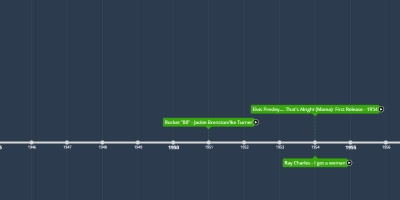2 jan 1955 ano - Chuck Berry - Maybellene
Descrição:
Distantly modeled on a country number called “Ida Red” but the primary elements of “Maybellene” trace their roots clearly to rhythm & blues: the thick, buzzing timbre of Berry’s electric guitar (see Box 3.2); the bluenotes and slides in both voice and guitar; the socking backbeat of the drum; and
the form, derived from twelve-bar blues structures.
What, then, made “Maybellene” sound so startlingly new? The explosive
tempo, for one thing; while bands occasionally may have played for dancing at
a tempo like this, no vocal-based rhythm & blues had ever gone at this pace, because
it’s exceptionally hard to articulate words, and have time to breathe, when
trying to sing at this tempo. But Berry pulls it off, articulating the words with clarity and remarkable force. This brings up another essential aspect of the record’s novelty and appeal, which is the lyrics themselves. The lyrics to “Maybellene” provide an original and clever description of a lovers’ quarrel in the form of a car chase, complete with a punning invented verb form (motorvatin’ ), humorous details (“Rain water blowin’” under the automobile hood, which is “doin’ my motor good”), and a breathless ending in which the singer catches
Maybellene in her Cadillac at the top of a hill—an ending that still leaves listeners
room to imagine a wide range of sequels. And what could reach out
to a young audience more effectively than a story featuring both cars and sex
appeal?
The form of “Maybellene” is clearly based on the twelve-bar blues. The chorus
(“Maybellene, why can’t you be true?”) adheres to the traditional twelve-bar
structure in every respect: three four-bar phrases, standard chord pattern, and
even a traditional three-line poetic arrangement where the second line is a repetition
of the first. But the verses, while twelve bars long, completely suppress
chord changes, remaining on the “home” (or tonic) chord throughout while the
voice delivers rapid-fire lyrics using brief, repetitive patterns of notes (see listening
chart). Ironically, by eliminating chord changes and restricting melodic interest
in the verses, Berry turns what could have been a static, purely strophic
form into something more dynamic. Instead of a string of standard twelve-bar
blues stanzas, we hear an alternating verse-chorus structure that allows Berry to
tell his story, and to build his record, in a more exciting way.
Adicionado na linha do tempo:
Data:
2 jan 1955 ano
Agora
~ 69 years ago

